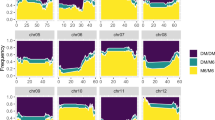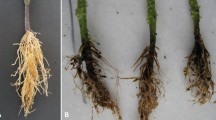Abstract
A cross between the cultivated tomato Lycopersicon esculentum and a related wild species L. cheesmanii yielded 97 recombinant inbred lines (RILs) which were used to construct a genetic map consisting of 132 molecular markers. Significant deviation from the expected 1:1 ratio between the two homozygous classes was found in 73% of the markers. In 98% of the deviating markers, L. esculentum alleles were present in greater frequency than the L. cheesmanii alleles. For most of the markers with skewed segregation, the direction of the deviation was maintained from F2 to F7 generations. The average heterozygosity in the population was 15%. This value is significantly greater than the 1.5% heterozygosity expected for RILs in the F7 generation. On average, recombination between linked markers was twice as high in the RILs than in the F2 population used to derive them. The utility of RILs for the mapping of qualitative and quantitative traits is discussed.
Similar content being viewed by others
References
Allard RW (1956) Formulas and tables to facilitate the calculations of recombinational values in heredity. Hilgardia 24:235–278
Bailey DW (1981) Recombinant inbred strains and bilineal congenic strains. In:Foster HL, Small JD, Fox JG (eds) The mouse and biomedical research. Academic Press, New York, pp 223–239
Behare J, Laterrot H, Sarfatti M, Zamir D (1991) Restriction fragment length polymorphism-mapping of the Stemphylium resistance gene in tomato. Mol Plant-Microbe Interact 5:489–492
Bernatzky R, Tanksley SD (1986) Methods for detection of single or low-copy sequences in tomato on Southern blots. Plant Mol Biol Rep 4:37–41
Burr B, Burr FA (1991) Recombinant inbreds for molecular mapping in maize. Trends Genet 7:55–60
Burr B, Burr FA, Thompson KH, Albertson MC, Stuber CW (1988) Gene mapping with recombinant inbreds in maize. Genetics 118:519–526
Goldman I, Paran I, Zamir D (1994) Quantitative trait locus analysis of a recombinant inbred line population derived from a Lycopersicon esculentum x L. cheesmanii cross. Theor Appl Genet (in press)
Ellis THN, Turner L, Hellens RP, Lee D, Harker CL, Enard C, Domoney C, Davied DR (1992) Linkage maps in pea. Genetics 130:649–663
Heun M, Kennedy AE, Anderson JA, Lapitan NLV, Sorrells ME, Tanksley SD (1991) Construction of a restriction fragment length polymorphism map for barley (Hordeum vulgare). Genome 34:437–447
Lander ES, Green P, Abrahamson J, Barlow A, Daly MJ, Lincoln SE, Newburg L (1987) MAPMAKER: An interactive computer package for constructing primary genetic maps with experimental and natural populations. Genomics 1:174–181
Lefebvre V, Prwevost T, Palloix A (1992) Segregation of molecular markers in doubled haploid progenies of pepper. In: Belletti P, Quagliotti L (eds) VIII Meeting “Genetics and breeding of Capsicum and Eggplant”, September 1992, Rome, Italy, pp 232–237
Lister C, Dean C (1993) Recombinant inbred lines for mapping RFLP and phenotypic markers in Arabidopsis thaliana. Plant J 4:745–750
Manly KF (1993) A Macintosh program for the storage and analysis of experimental genetic mapping data. Mammal Genome 4:303–313
Mansur LM, Orf J, Lark KG (1993) Determining the linkage of quantitative trait loci to RFLP markers using extreme phenotypes of recombinant inbreds of soybean (Glycine max L. Merr). Theor Appl Genet 86:914–918
Nienhuis J, Helentjaris T, Slocum M, Ruggero B, Schaefer A (1987) Restriction fragment length polymorphism analysis of loci associated with insect resistance in tomato. Crop Sci 27:797–803
Paterson AH, Wing RA (1993) Genome mapping in plants. Curr Opin Biotechnol 4:142–147
Paterson AH, Lander ES, Hewitt JD, Peterson S, Lincoln SE, Tanksley SD (1988) Resolution of quantitative traits into Mendelian factors by using a commplete linkage map of restriction fragment length polymorphisms. Nature 335:721–726
Paterson AH, Damon S, Hewitt JD, Zamir D, Rabinowitch HD, Lincoln SE, Lander ES, Tanksley SD (1991) Mendelian factors underlying quantitative traits in tomato: comparison across species, generations, and environments. Genetics 127:181–197
Reiter RS, Williams JGK, Feldmann KA, Rafalsky JA, Tingey SV, Scolnik PA (1992) Global and local genome mapping in Arabidopsis thaliana by using recombinant inbred lines and random amplified polymorphic DNAs. Proc Natl Acad Sci USA 89:1477–1481
Rick CM, Butler L (1956) Cytogenetics of the tomato. Adv Genet 8:267–382
Simpson SP (1989) Detection of linkage between quantitative trait loci and restriction fragment length polymorphisms using inbred lines. Theor Appl Genet 77:815–819
Stevens AM, Rick CM (1986) Genetics and breeding. In: JG Atherton, J Rudich (eds) The tomato crop. Chapman and Hall, pp 35–110
Tanksley SD, Ganal MW, Prince JC, de Vicente MC, Bonierabale MW, Broun P, Fulton TM, Giovanonni JJ, Grandillo S, Martin GB, Messeguer R, Miller JC, Miller L, Paterson AH, Pineda O, Roder MS, Wing RA, Wu W, Young N (1992) High-density molecular linkage maps of the tomato and potato genomes. Genetics 132:1141–1160
Taylor BA (1978) Recombinant inbred strains: use in gene mapping. In: Morse HC (ed) Origins of inbred mice. Academic Press, New York, pp 423–438
Wang G, Mackill DJ, Bonman MJ, MsCouch SR, Nelson RJ (1994) RFLP mapping of genes conferring complete and partial resistance to blast in a durably resistant rice cultivar. Genetics 136:1421–1434
Zamir D, Bolkan H, Juvik JA Watterson JC, Tanksley SD (1993a) New evidence for placement of Ve-the gene for resistance to Verticillium race 1. TGC 43:51–52
Zamir D, Paran I, Eshed Y, Sarfatti M, Ori N, Fluhr R (1993b) Recombinant inbred populations for high-resolution mapping in tomato. In: Yoder J (ed) Molecular biology of tomato. Technomic Publishing Co, pp 49–58, Lancaster, Basel
Author information
Authors and Affiliations
Additional information
Communicated by M. Kornneef
Rights and permissions
About this article
Cite this article
Paran, I., Goldman, I., Tanksley, S.D. et al. Recombinant inbred lines for genetic mapping in tomato. Theoret. Appl. Genetics 90, 542–548 (1995). https://doi.org/10.1007/BF00222001
Received:
Accepted:
Issue Date:
DOI: https://doi.org/10.1007/BF00222001




